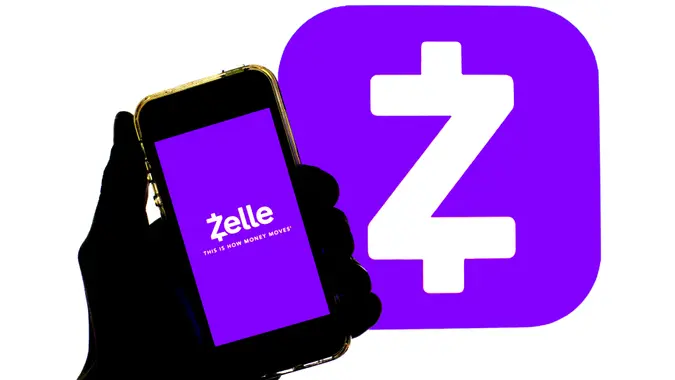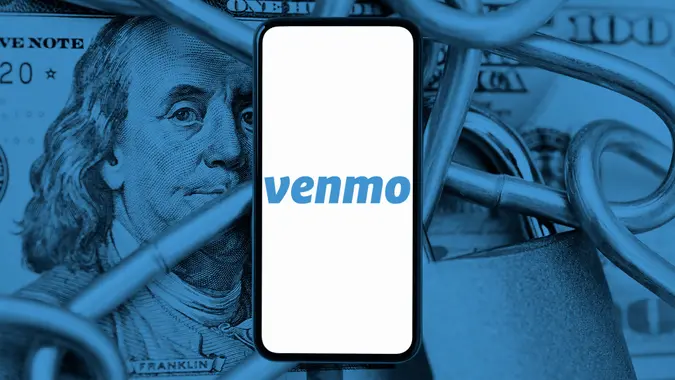How Does Venmo Make Money?

Commitment to Our Readers
GOBankingRates' editorial team is committed to bringing you unbiased reviews and information. We use data-driven methodologies to evaluate financial products and services - our reviews and ratings are not influenced by advertisers. You can read more about our editorial guidelines and our products and services review methodology.

20 Years
Helping You Live Richer

Reviewed
by Experts

Trusted by
Millions of Readers
If you’ve ever used Venmo to split the bill after dinner, pay your roommate for rent or even shop online, you might have wondered: How does Venmo make money if it’s free to use?
Venmo has become one of the most popular peer-to-peer (P2P) payment apps, making it easy to send and receive money with just a few taps. But while most transactions on Venmo come with no upfront costs, the company still needs to make money. So, how does that happen?
The answer: fees, business transactions, premium services and even cryptocurrency. Let’s dive into how Venmo turns a “free” app into a profitable business — and what you should know to avoid unnecessary fees.
What Is Venmo?
Venmo is a mobile payment app founded in 2009 that enables both consumers and businesses to send and receive funds.
The company has been a subsidiary of PayPal since 2013. With 60 million users, Venmo is one of the most popular payment apps. Venmo makes money in several ways, but some of its main revenue sources are transaction fees, partnerships and selling transaction data.
Another unique Venmo feature is how it works somewhat like a social media platform. Users can see transactions between their friends and other people and businesses whenever they open the app. Often, friends use Venmo to split bills at bars and restaurants. The app’s social element lends itself well to this scenario and as a result, it’s often the go-to between friends.
Venmo’s Business Model: How It Makes Money
Venmo, which is owned by PayPal, started as a simple way to transfer money between friends. Over time, it expanded services to generate revenue while still keeping transactions free for most users.
Venmo makes money in several ways, including:
- Transaction fees – Instant transfers and credit card payments
- Merchant payments – Fees businesses pay to accept Venmo
- Venmo debit and credit cards – Earns money through interchange fees and interest charges
- Business accounts – Premium services for business owners
- Cryptocurrency transactions – Fees for buying and selling crypto
While you may not notice these revenue streams in everyday use, they all add up to a thriving business model.
How Venmo Makes Money
Here’s a closer look at each of Venmo’s revenue sources and how they make money for the company.
1. Transaction Fees: Venmo’s Main Revenue Source
Venmo makes a large portion of its money from small fees on convenience features.
Instant Transfers: Paying for Speed
If you want to transfer money from your Venmo balance to your bank instantly, Venmo charges a 1.75% fee per transaction.
- Standard transfer (free) – Takes 1 to 3 business days.
- Instant transfer (1.75% fee, min $.25, max $25) – Money is available within minutes.
Since many users opt for instant transfers to get their money quickly, Venmo earns a steady stream of revenue from these small fees.
Credit Card Payments: Paying to Send Money
If you send money using a credit card instead of a bank account or debit card, Venmo charges a 3% fee. To avoid this fee, link a debit card or bank account when sending money.
2. Merchant Payments: Businesses Help Venmo Profit
Venmo isn’t just for sending money to friends — it’s also a growing payment option for businesses. When you pay a business using Venmo, the merchant is charged a 1.9% + $.10 transaction fee.
Why Do Businesses Accept Venmo?
- It’s convenient for customers, especially younger users.
- It integrates with PayPal and online stores.
- It offers social features, allowing users to share purchases with friends.
Since Venmo processes millions of business transactions daily, these fees add up fast, making it a key revenue stream.
3. Venmo Debit & Credit Cards: More Ways to Earn
Venmo has also introduced its own debit and credit cards, creating even more opportunities to make money through everyday purchases.
Venmo Debit Card
This card pulls money from your Venmo balance and helps Venmo earn money in two ways:
- Interchange fees – Venmo gets a small percentage of each transaction.
- Cashback partnerships – Venmo earns commissions from retailers when you shop with cashback offers.
Venmo Credit Card
Venmo’s credit card generates revenue through:
- Interest charges on unpaid balances.
- Merchant transaction fees.
If you use a Venmo credit card, paying off your balance can help you avoid high interest fees.
4. Venmo for Business Accounts: Paid Features & Fees
Venmo allows businesses to accept payments through “business profiles,” offering extra features in exchange for transaction fees.
Business Profile Fees
- 1.9% + $.10 per transaction for business payments.
- Premium features, like sales tracking and invoicing (coming soon).
For small business owners, Venmo’s fees are often lower than credit card processing fees, making it an attractive payment option.
5. Cryptocurrency Transactions: A New Revenue Stream
Venmo now allows users to buy, sell and hold cryptocurrency, including Bitcoin and Ethereum.
How Venmo Makes Money From Crypto
There’s a lot to consider when it comes to crypto. Here’s a quick breakdown of the prices for trades:
- Transaction fees on crypto trades:
- $.50 for purchases under $25
- 1.5% fee for transactions over $200
- Spread fee on exchange rates: Venmo profits from the difference between the buy and sell price of crypto.
While Venmo’s crypto feature is convenient, you might find lower fees on dedicated crypto exchanges like Coinbase or Binance.
How Venmo Compares to Other Payment Apps
Venmo isn’t the only app making money from transactions. Here’s how it compares to other popular digital wallets:
| Feature | Venmo | Cash App | Zelle | PayPal |
|---|---|---|---|---|
| Instant Transfer Fees | 1.75% | .5% – 1.75% | No | 1.75% |
| Credit Card Fees | 3% | 3% | N/A | 2.9% + $.30 |
| Merchant Payments | Yes (1.9% + $.10) | Yes (2.75%) | No | Yes (varies) |
| Crypto Trading | Yes | Yes | No | Yes |
Each app has its pros and cons, but Venmo’s social features and business integrations make it stand out.
Final Thoughts to GO: How Venmo Makes Money
Venmo may feel like a free app, but its business model is built around fees, business payments and premium features.
For most users, Venmo is free to use, but if you need instant transfers or pay with a credit card, you’ll be paying small fees that add up over time.
Want to avoid fees? Stick to bank transfers, debit card payments, and standard withdrawals. And if you’re a business owner, Venmo can be a great tool — just watch out for those transaction fees.
FAQs About How Venmo Makes Money
Although the basic idea behind apps and services like Venmo can be simple to understand, there are still many common questions surrounding them, in part because there are so many different kinds. Here are the answers to some of the most frequently asked questions regarding how Venmo makes money:- Does Venmo charge fees for personal transactions?
- No, sending money to friends and family is free if you use a bank account or debit card. However, credit card payments come with a 3% fee.
- How does Venmo make money if most transactions are free?
- Venmo earns revenue through merchant payments, instant transfer fees, credit card fees, and premium services like business accounts and cryptocurrency trading.
- Does Venmo sell user data for profit?
- No, Venmo does not sell user data. However, it may share information with PayPal and third-party partners to improve services.
- What are the costs of using Venmo for businesses?
- Businesses pay a 1.9% + $0.10 fee per transaction when accepting payments through Venmo.
- How does Venmo make money from cryptocurrency transactions?
- Venmo charges fees on crypto trades and profits from the difference between buy and sell prices.
Information is accurate as of Feb. 24, 2025.
Editorial Note: This content is not provided by any entity covered in this article. Any opinions, analyses, reviews, ratings or recommendations expressed in this article are those of the author alone and have not been reviewed, approved or otherwise endorsed by any entity named in this article.
Our in-house research team and on-site financial experts work together to create content that’s accurate, impartial, and up to date. We fact-check every single statistic, quote and fact using trusted primary resources to make sure the information we provide is correct. You can learn more about GOBankingRates’ processes and standards in our editorial policy.
- Venmo "Venmo.com"
- Paypal "Paypal"
- Venmo "Fees with your Venmo Account"
- Venmo "Instant Bank Transfer FAQ"
- Venmo "Fees & Venmo"
- Venmo "Business Profile Transaction Fees"
 Written by
Written by  Edited by
Edited by 
























